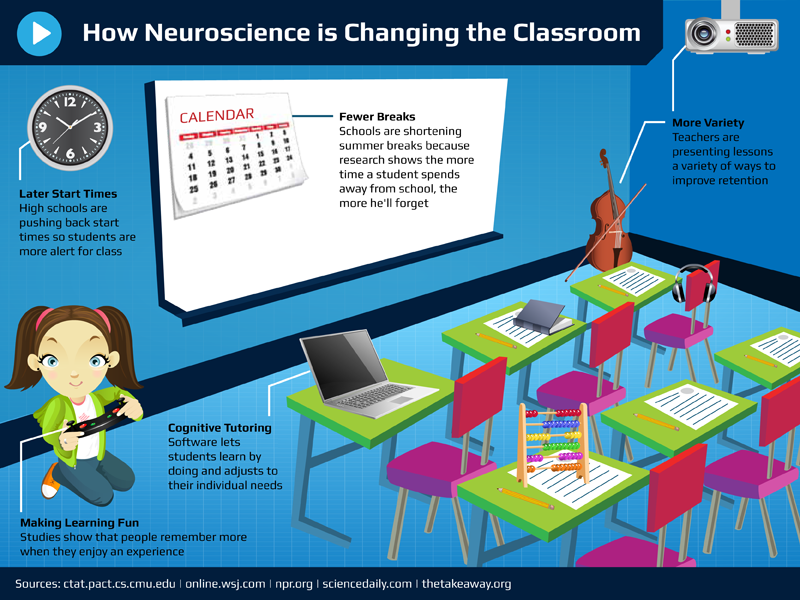There is often a big divide between what happens in the laboratory and the way laboratory findings are practically applied. The relationship between neuroscience research and education is no exception. While there are numerous educational products that claim to be based on neuroscience research (often quite dubiously so), the real impact of brain-based research on education has been much more subtle.
While neuroscience hasn’t yet radically changed the way we think about teaching and learning, it is helping to shape educational policies and influencing new ways of implementing technology, improving special education, and streamlining day-to-day interactions between teachers and students. While there is still a long way to go before we truly understand the science of learning and how to use those findings in the real world classroom, it’s important to highlight some of the key ways that neuroscience is changing the classroom of today for the better.
The article goes on to describe nine ways neuroscience research is influencing education
- Cognitive tutoring: […] The cognitive tutoring programs allow students to learn by doing and are based on cognitive psychology theory, employing an AI system to adjust to student needs as well as to track student progress and thought processes so teachers can better help them learn.
- High schools starting later: Neuroscience research has demonstrated that sleep patterns change, often significantly, as individuals age. Multiple studies have found that adolescents need more sleep than other age groups and are unlikely to function at peak cognitive capacity early in the morning. In addition to needing more sleep, teens also simply have different circadian rhythms, which often makes them drowsy and moody in the morning. Many schools are starting to use this data to make changes, pushing back start times to allow students to sleep in a little later.
- Offering more variety: Repetition can be a valuable learning tool, no matter what you’re trying to learn, but neuroscience research has pinpointed a “spacing effect,” demonstrating that students learn more when episodes of learning are spaced out over time rather than pushed into one single episode. One of the ways this manifests itself is by bringing greater variety into the classroom, with lessons extending over the course of a semester rather than being fit into a few days or weeks. Researchers have also found that variety is key in learning because, simply put, the brain craves it, boosting levels of both attention and retention in students.
- Individualized education: While our general brain anatomy is similar, neuroscience is showing that no two brains work exactly alike. […] learning tools that are adaptable to individual needs are especially valuable in the classroom. New, highly plastic digital tools are filling part of that role, but neuroscience and education are taking this information in another direction as well. Teachers are being encouraged to expose students to novel experiences when presenting information […].
- Understanding that you use it or lose it: […] Anyone who has ever tried to remember lessons from grade school decades later can attest to this, but neuroscience backs it up, demonstrating that people who read more challenging books often have a greater variety and number of neural connections. […] Research has shown that the more time students spend outside of school, the more they’ll forget, leading to more work to regain lost information. As a result, many schools are shortening summer breaks or going to a year-round schedule in order to reduce the amount of time students are away from their studies.
- Better identification and intervention for learning disorders: Neuroscience research is making it easier to identify which students have learning disabilities and to get those students interventions that can significantly help their academic performance. Through neuroscience research, new biomarkers and diagnostic strategies for disabilities like ADHD and dyslexia have been identified, in turn leading to more successful early interventions for students and some potentially amazing tools to help students learn. […]
- Making learning fun: Increasingly, neuroscience is demonstrating the importance of making learning a fun and positive experience. Pleasurable experiences cause the body to release dopamine, which in turn helps the brain remember facts. One great example of how this is making it into the classroom is Khan Academy, an online learning portal that challenges students to complete games and problem sets in order to win badges. […] Recent research has also shown just how much of an emotional experience learning can be, with negative emotional states like fear, anxiety, shame, or worry making it difficult or impossible for students to reason, learn, or store new memories. This data further stresses the need for developing learning environments that are not just fun but are also positive, safe places for students.
- Making learning social: Human beings are highly social creatures, so it should come as no surprise that neuroscience would point to a positive effect from social learning experiences. A study by teacher and neurologist Judy Willis in 2011 found that students who worked on writing in positive, supportive groups experienced a surge in dopamine (which we’ve already discussed the positive effects of), as well as a redirection and facilitation of information through the amygdala into the higher cognitive brain, allowing students to better remember information over the long term. She also found that learning in groups tended to reduce anxiety, which can frequently be a major roadblock to effective learning. […]
- Focus on neuroeducation: […] Through practice, it’s actually possible to change the way our brains are structured, adding more brain connections and changing neural pathways through the neuroplasticity afforded by our brain cells. […] Educators are increasingly encouraging administrators to move away from memorization-based learning to programs that ask students to solve problems, think critically, and explore creativity, as these methods not only build knowledge but also enhance and build brain pathways themselves, prepping the brain for future educational experiences.

